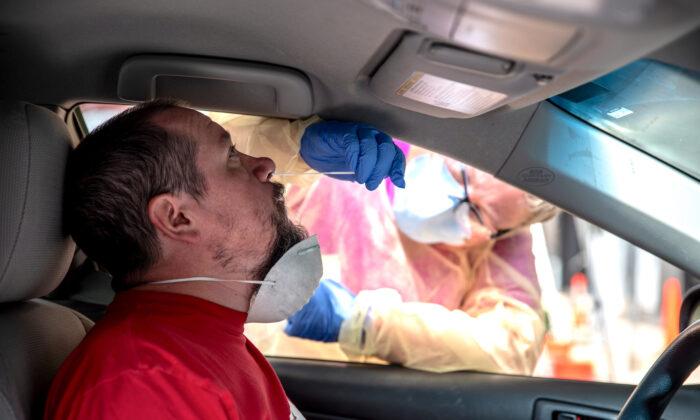When George Washington posed for the iconic Lansdowne portrait, his lips were firmly shut, helping create an image of his noble, stoic character. Another reason for the pursing may however, have been to mitigate the pain caused by his false teeth.
Due to an unfortunate combination of genetics, diet, and disease, America’s first president started losing his teeth in his 20s and lived his whole life with a series of dentures—all of which caused him discomfort, changed his features, and made it difficult to eat and talk, according to records of the Mount Vernon Estate.
While Washington’s case of periodontal disease, or disease of the gums, is uncommon for its extremity, this affliction affects over three-quarters of all adults.
While some is genetic, the vast majority of periodontal disease is preventable with proper cleaning, according to periodontist Dr. Alan Pollack, who practices on the Upper East Side.
Periodontal disease, the extreme form of gingivitis, forms under the gums when plaque is allowed to accumulate in the space between the gums and tooth root. Pathogenic bacteria forms in the anaerobic environment there and migrates down along the tooth root, causing the gum to detach from the tooth, creating a deeper-than-normal gum pocket. The bacteria eventually reach the bone under the tooth and, in tandem with the body’s own immune defense enzymes, eat away at the bone and connective tissues that hold teeth in their sockets.
Early signs of gum disease include bleeding gums and a bad taste in the mouth; loose teeth indicate more advanced stages.
Dr. Pollack said the vast majority of people won’t get severe periodontitis. Dentists now are “pretty good at picking it up ealier and that’s gone a long way to reducing the amount of gum disease that we actually see, especially in this part of the world,” he said.
Periodontal disease is chronic and has no cure or long-term medication to treat it, but gum health can usually be maintained with proper home cleaning and routine professional cleaning to get the bacteria hiding in deeper pockets.
“We [periodontists] really focus on keeping your teeth clean and the gums as healthy as possible and also trying to get the pockets as shallow as possible,” Dr. Pollack said.
Replacing Lost Teeth
“The essence of periodontics is to try and save your teeth,” Dr. Pollack said.
Accidents, injury, and disease, sometimes make this impossible. And when one, several, or a whole row of teeth can’t be saved, modern dentistry can replace them with dentures, bridges, and most recently, tooth implants.
Dentures are removable sets of teeth, bridges are made from crowns that are put on filed down teeth on either side of a missing tooth. The crowns hold another false tooth in place between them like the anchorage blocks on either end of a bridge.
Tooth implants are metal posts placed in gums where teeth are missing. The posts are capped with crowns that look and feel like natural teeth. Implants can replace one or an entire mouth of missing teeth and can also help stabilize dentures.
Implants are “one of the biggest advances in dentistry in the past 40 years,” according to the American Dental Association, (ADA) and had they been around in Washington’s time he probably would have opted for them, because he said his dentures were “both uneasy in the mouth and bulge my lips out” and that the teeth in them “have, by degrees, worked loose.”
Implant History
However, Washington would have had to wait over 200 years after the founding of the country in order to have a set of implants, because the first tooth implants were not done in America until the early ‘80s.
This is because more than just wiring or gluing posts in the mouth, tooth implants are stabilized by re-growing bone around the post.
The technology for tooth implantation was first discovered in Sweden in the 1960s by an orthopedist researching prosthetics, who found that bone cells will grow around and adhere themselves to titanium. While the discovery didn’t help the doctor achieve his initial goal—to make replacement feet—it did greatly expand the possibilities for replacing lost teeth.
However, it took a number of years for doctors to figure out how to make implants successful and not major surgery for patients.
Dr. Pollack is one of the earlier practitioner in New York in the field of tooth implants. He traveled to Sweden in 1986 to learn the early implant techniques—which he said were pretty primitive compared to what dentists are able to do today.
“We used to do [implant surgery] with full sterility, so we‘d have the patient change into scrubs and we’d cover them with betadine [antiseptic] swabs around their mouth, cover them with sterile drapes like you’re going to the OR [operating room] in the hospital, and we would wear full sterile garb.”
The average healing time back then was six months for implants in the upper jaw and three months for the lower. Now recovery time is as little as 6 to 8 weeks for both jaws with a 98 percent success rate for implant surgeries.
One of the major turning points was in the 90s when doctors switched from using smooth posts to modifed ones with a rougher surface that the bone cells prefer. “They grow across it faster and they adhere to it quicker and better,” Dr. Pollack said.
U.S. dentists placed around 5.5 million implants in 2011, according to the ADA.
When Are Implants Right?
There is no clear-cut formula for deciding whether dentures, a bridge, or implants is best. Patient preference, doctor experience, and the comfort, aesthetic, and long-term functioning of the natural or artificial teeth are key factors in the decision.
For example, many patients find dentures to be the easiest solution; they don’t mind removing and cleaning them, and they find them comfortable for decades.
But for others they’re not good enough. They may not fit so well, they tend to move and get food underneath them, and after wearing them for years the bone underneath wears away and they start to move or fall out, Dr. Pollack said. Young people in particular don’t like the aesthetic of dentures.
Bridges look, and feel more like natural teeth but require drilling away the enamel covering of healthy teeth—which some people don’t like, Dr. Pollack said.
The choice is never easy, but after having placed thousands of implants and “seeing the pros and cons of both the bridges and the implants,” Dr. Pollack said he is able to recommend which option will work the best for a patient.
Implant Innovations Coming Down the Pipeline
As with any surgical procedure, implants do come with risks. Periodontists are currently working on how to prevent and treat peri-implantitis, which is gum disease that forms around the implants.
Dr. Pollack said that in a few years, he hopes there will be a way to prevent this, but until then good home cleaning and regular professional cleanings are crucial, just like for regular periodontitis.
As for new technology: “My approach has always been to let other people make the mistakes with the latest and greatest' advances and then see what works and what doesn’t work, and adopt it early. An early adopter I guess is a better way of putting it.”
You May Want to Consider Dental Implants If You:
- Are self-conscious due to missing teeth
- Wear dentures that are uncomfortable
- Are unsatisfied with your removable partial dentures
- Do not want to have an intact tooth structure removed for a fixed bridge placement.
Many patients choose implants to replace a single tooth, several teeth, or to support a full set of dentures.
SOURCE: American Dental Association
Pollack Periodontal Associates, PC
225 E. 64th St.
New York
212-838-0940
www.ppa-nyc.com/





